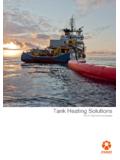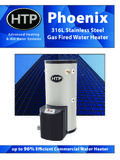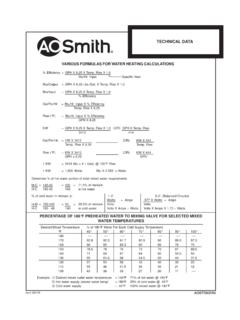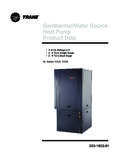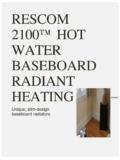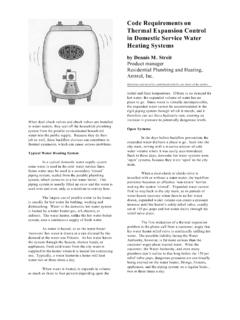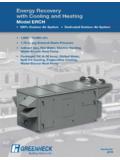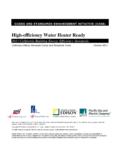Transcription of Tank Heating Solutions - PARAT Halvorsen AS
1 Tank Heating SolutionsFor Oil Spill Response VesselsOil spill incidents are unplanned and unwanted events that can have dire consequences for the environment and fragile ecosystems around the globe. Fast response combined with the correct equipment able to cope with any type of hydrocarbon emulsion is vital to minimize the risk involved in extracting, processing and transporting petrochemicals outside our coastlines. PARAT Halvorsen , in close cooperation with yards and ship owners, has developed a system that strengthens one vital part of the response value-chain in a very cost efficient way. A Heating system that is fully integrated into the response vessels utility and heat recovery loop and that in moments can be re-mobilized to deliver steam through specially engineered injection nozzles into the tanks that carry recovered hydrocarbons. PARAT Halvorsen is a Norwegian technology company providing state of the art Solutions for steam- or other heated medium based processes.
2 PARAT has delivered boilers and heaters to the marine and offshore markets since chain is only as strong as its weakest Exploration and production of hydrocarbons off coast-lines around the world is increasing. Reliable oil spill response Solutions are essential, and the focus on this type of technology is constantly growing. PARAT has been working on the transportation aspects of this problem for years now. Ships store the oil recovered from the sea in tanks , and the oil needs to stay viscous so the tanks can be emptied. This is done by injecting steam into the emulsion during the Prestige oil spill incident in the Bay of Biscay in 2002 it was discovered that the recovered oil settled quickly in the storage tanks and became too thick to be pumpable. The only way to get it out was mechanically. In order to increase the viscosity, steam was injected directly into the tanks .
3 In the aftermath, NOFO (Norwegian Clean Seas Asso-ciation for Operating Companies), developed a basic standard for vessels to be approved for oil spill recovery operations which specifically requires tank Heating to be part of the vessels basic equipment. When presented with such an opportunity, PARAT Halvorsen worked closely together with the yards and owners to find and develop the most space and cost efficient solution available. This involves integrating the vessel hot water loop with the contingency steam injection tank Heating system. In case of oil pollution to the sea surface, the oil will be recovered and stored in tanks in the oil recovery ships until it can be delivered for processing. Experience from such situations has shown that the oil must be heated to maintain a sufficient viscosity for offloading. To ensure that the recovery vessels can operate efficiently, NOFO has made regulations requiring a sufficient Heating system for the tanks on board.
4 Presently, such oil tanks are heated by steam from a boiler on board. The steam is in many cases delivered to several nozzles installed around the perimeter of the tank. To achieve an adequate distribution of steam and heat in the tank multiple nozzles must be an installation has several drawbacks. One is the necessity of many openings in the tank. Another is the need of a manifold to distribute the steam. Both these features lead to a lot of couplings and gaskets that may develop leaks, and which are costly. Even with several nozzles installed, the heat distribution may be insufficient, leaving spaces such as the area around the tank outlet in the bottom in a cold shadow. There may also be insufficient space around the tank for such a large installation. Often the tank is accessible only in a small sector of its circumference, making it difficult to provide a sufficient number of steam inlets.
5 PARAT Halvorsen has developed a multi nozzle arrangement that ensures a better distribution of heat in the oil recovery tank and at a lower cost than previously mentioned alternatives. This is achieved with a distribution system which is capable of Heating the whole tank from one insertion point. The arrangement reduces the need for complicated assemblies in the tanks , and also ensures that it is sufficient with one nozzle system per tank. Permanent installationThe multi nozzle steam lance will be designed and optimized for each tank. For tanks where entrance is not allowed, the lance must be installed permanently. To enable permanent installation the nozzle heads are fitted with rupture discs that ensure that there will be no ingress of pollution to the nozzle head when the lance is not in operation. STEAM BACKUP dedicated steam boiler installed as a 100% backup system, which will only be in operation when the vessel is in Oil Recovery BOILER WITH TWO PHASE HEAT EXCHANGER steam boiler provides heat to the vessels hot water loop through a steam/hot water heat exchanger.
6 In Oil Recovery mode, a small flow is still routed through the heat exchanger to provide sufficient heat for the critical HVAC consumers. COMBINED STEAM AND HOT water BOILER boiler fully integrated in the vessel hot water and heat recovery loop. When in Oil Recovery mode the boiler is dedicated to supply steam for tank Heating , and the HVAC-loop is maintained with a bypass system. The system is patented by PARAT Halvorsen . TheoryVarious basic concepts :Multi nozzle lanceIntegrated SolutionOil Recovery ModeNormal OperationBoiler in Steam ModeExpansion TankCirculation PumpDomestic HeaterHot water TankHVACBack-up HeaterFeed water PumpFeed water TankSoftening FilterMake up water <Engine Heat RecoveryORO TanksSteam Nozzle in ORO TanksSteam Lance on DeckDouble Block & Bleed arrangementFlow Control ValveBoiler in Hot water ModeExpansion TankCirculation PumpDomestic HeaterHot water TankHVACE ngine Heat RecoveryFlow Control ValveNORMAL OPERATION: During normal operation the boiler is part of the vessel hot water loop.
7 When the heat demand is higher than the heat recovered from the engines, the boiler will start and supply the additional energy required, as shown in figure RECOVERY MODE:If an emergency should occur, the boiler is isolated from the hot water loop. Heating for critical HVAC consumers is maintained by a compact back-up heater. The water level is lowered and the boiler is switched to steam mode. Steam is then supplied directly to the tanks that contain recovered oil. This is shown in figure 2. (Figure 1)(Figure 2)To save space, cost and to ensure proper functioning of the boiler equipment, it is smart to ensure that the boiler is in constant operation and part of the overall vessel HVAC system. PARAT Halvorsen has solved this as illustrated above. SteamFeed WaterHot water LoopCold water ReturnHot water LoopCold water ReturnTank Heating SolutionsFor Oil Spill Response Vessels137652411121.
8 Boiler with Back-up heater 2. water Treatment System 3. Engine Heat Recovery 4. Feedwater Pump 5. Expansion Tank 6. Circulation Pumps 7. Domestic Heater 8. Tank Heating 9. HVAC 10. Block & Bleed System 11. Multi Nozzle Steam Lance 12. Hand Held steam lance1089 The Combined steam and hot water boiler, which is patented by PARAT Halvorsen , is in daily use as it is fully integrated in the vessels hot water loop. Typical duty: 1250kWPARAT Halvorsen has developed a handheld steam lance for con-nection to a steam outlet on the vessels deck. The hand held steam lance can be used for removal of oil spill on deck and equipment and for de-icing. The lance is delivered with an 25m insulated steel hose. The multi nozzle steam lance is installed through a flange connection in the tank, and should be installed as close to the tank suction outlet as possible. When steam is required for tank Heating , a small back-up heater keeps up the temperature in the hot water loop.
9 Typical duty: 200kW. The heater is normally placed on top of the boiler. We based our tests on the specific requirements in the NOFO 2009 requirements. All the vessel s ORO tanks must be equipped with a permanent system for Heating recovered oil/emulsion. The system must make it possible to raise the temperature 15 C for a volume of 1000m3 within a period of 12 hours; calculated for a sea temperature of 5 C and an air temperature of 0 C. The calculations set a specific Heating capacity at kJ/kg/ C which is the typical value for a 50% mix of oil and water . It must be possible to use the entire capacity of the heat source in a random maximum combination of 3 tanks . Based on this the required energy input can be calculated as follows:Q = ( * * 3440J/kgK *15 C) (12hrs * 3600s/hr) Q = 1194kW (1790 kgs/h) This means that you need 400kW of heat input in each tank to fulfil the requirements.
10 The warm water Solutions currently on the market are based on compact coils installed in flanged connections in the side of the tanks . To achieve the sufficient heat transfer from the coils to the oil, you theoretically need to circulate the medium over the Heating surfaces with a significant velocity. Initial tests performed with this concept were done in water . water is a medium with very good heat transferring properties, through natural convection. The reason for this is the low viscosity and high conduc-tivity of water . For hydrocarbons, viscosity is far higher and conductivity far lower. The high viscosity will lead to the accumulation of heated emulsion around the coil that isolates the mass from further heat transfer because the T is reduced. In theory, we therefore expect a large reduction of heat transfer with the coil in question when used in hydrocarbons. In order to test this out we first tried the coil in water to document the coil s energy output.
